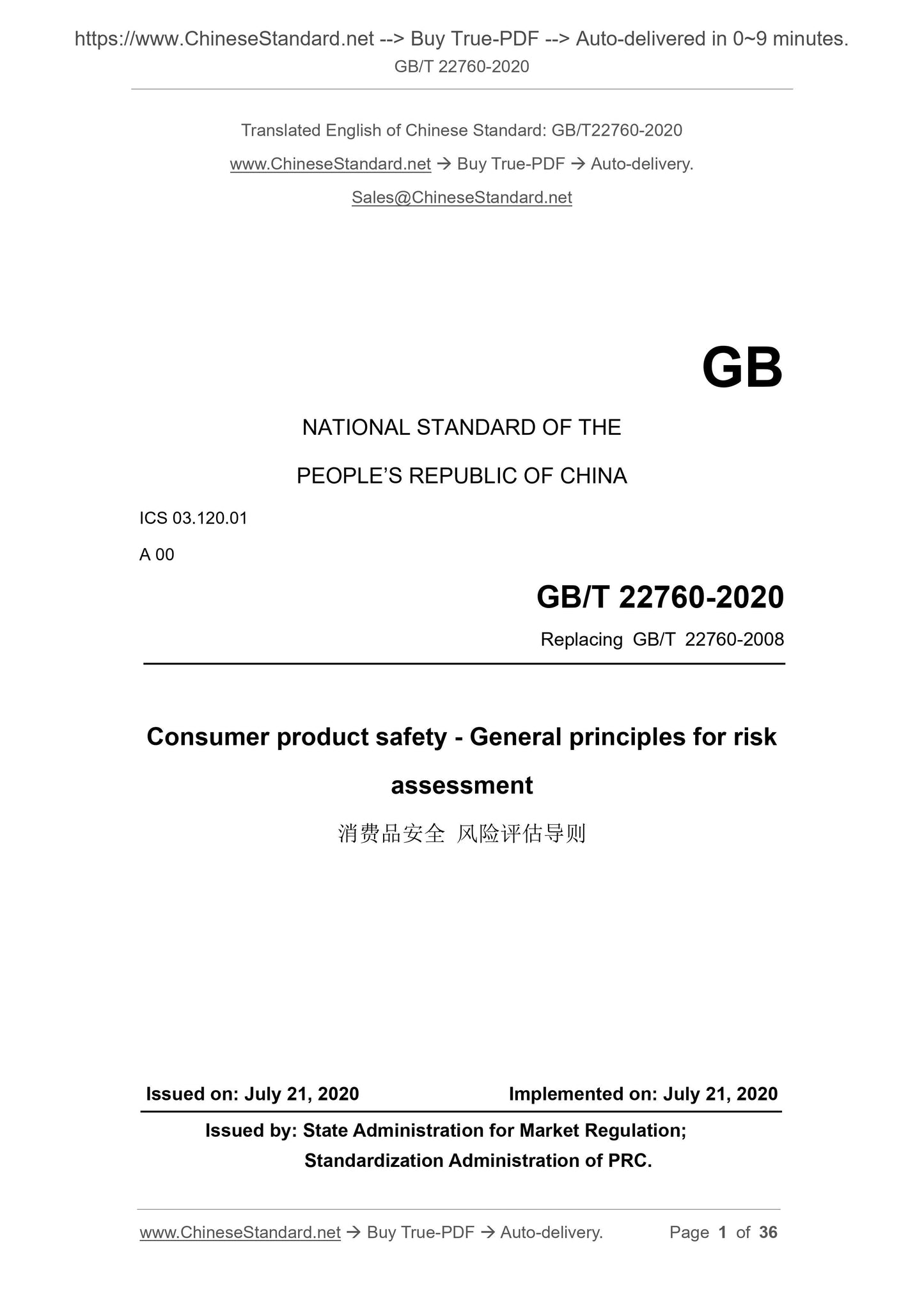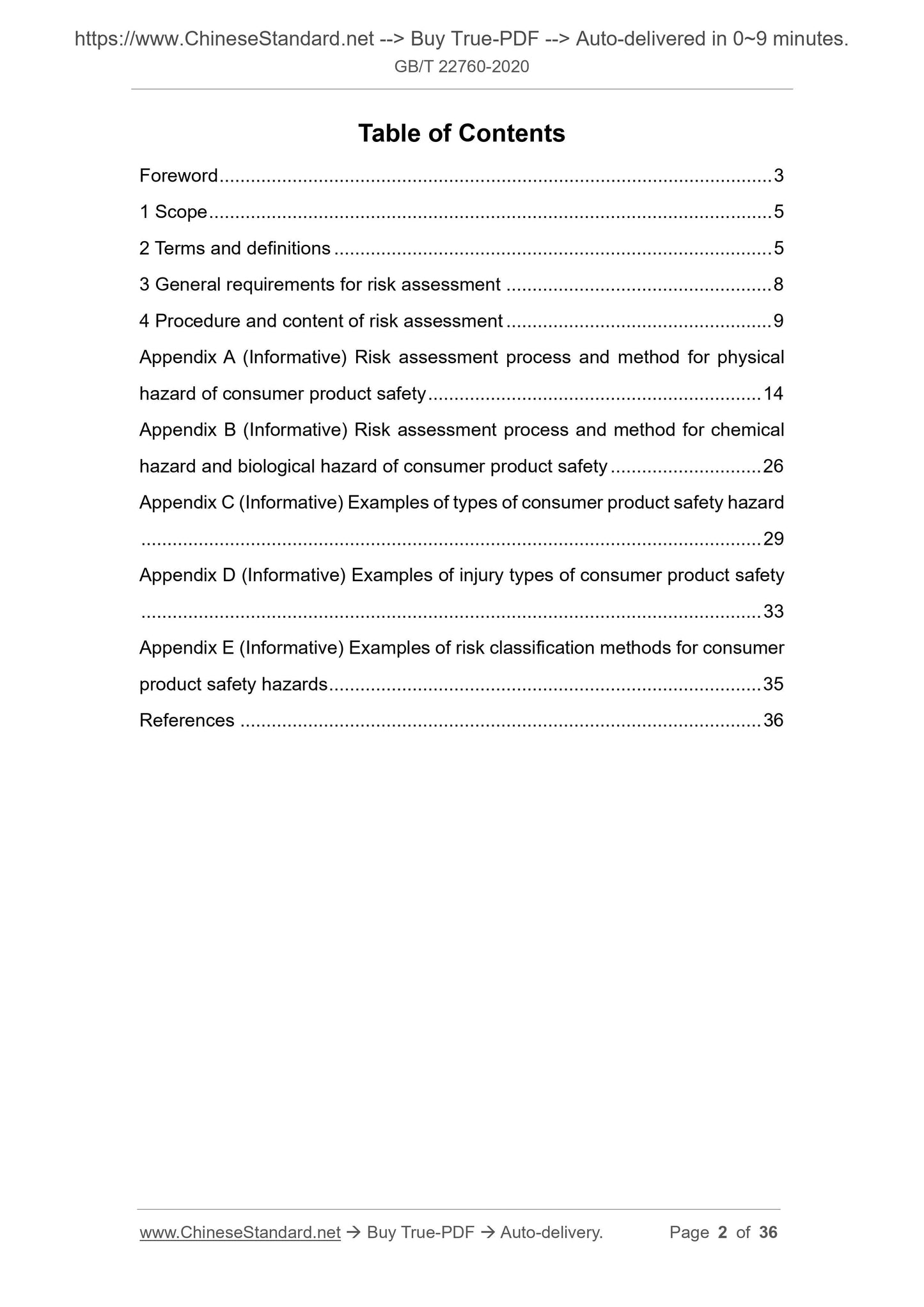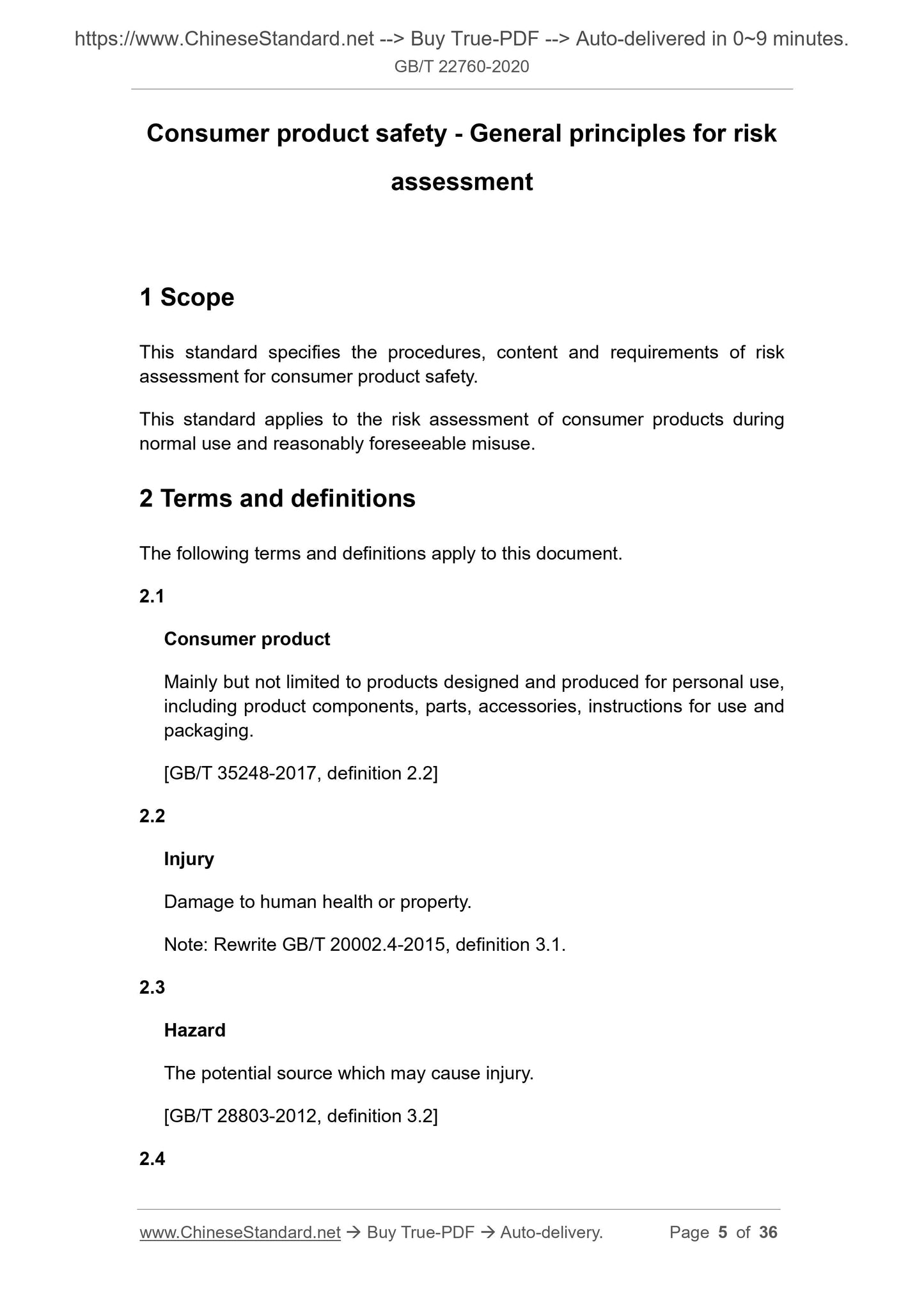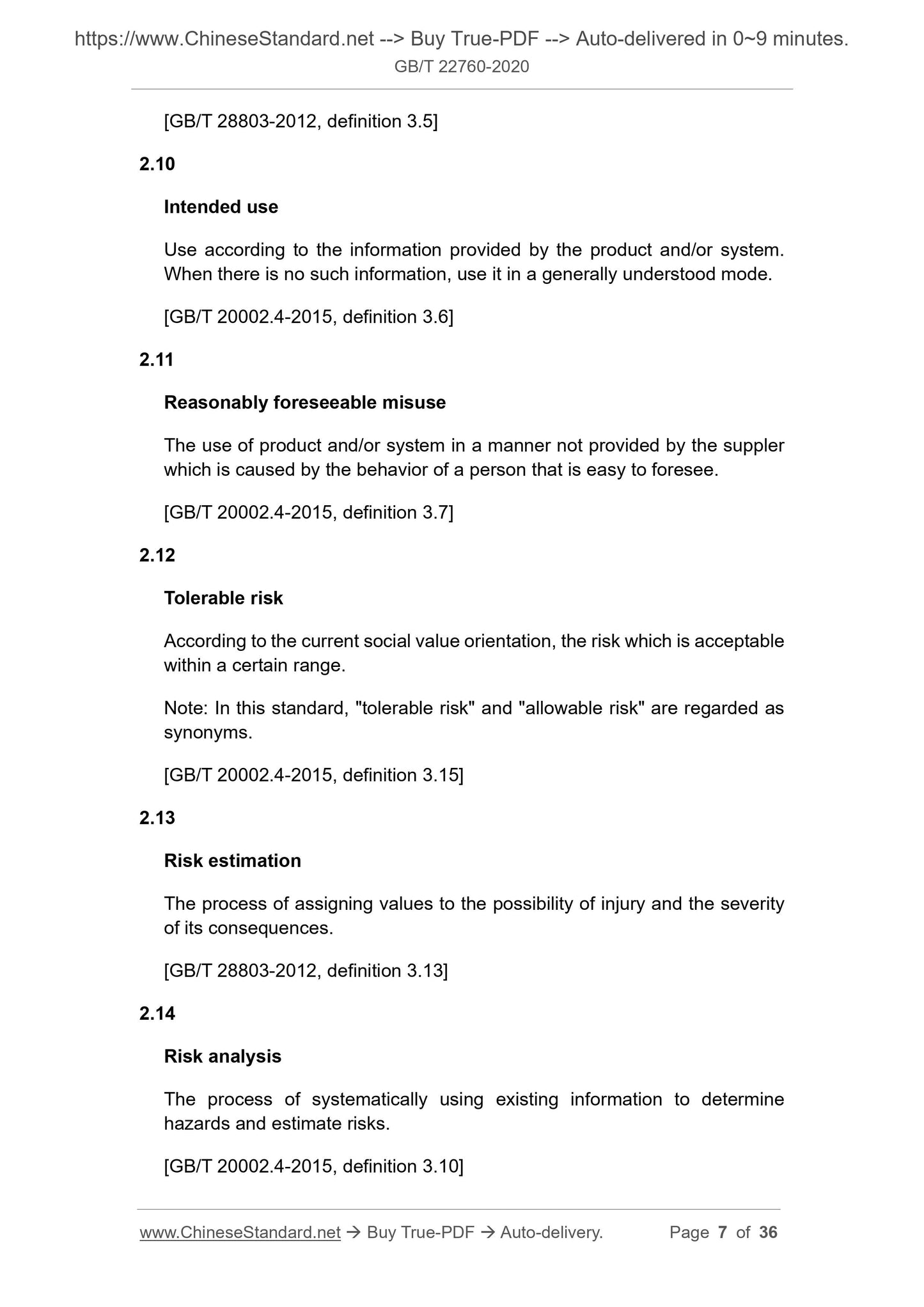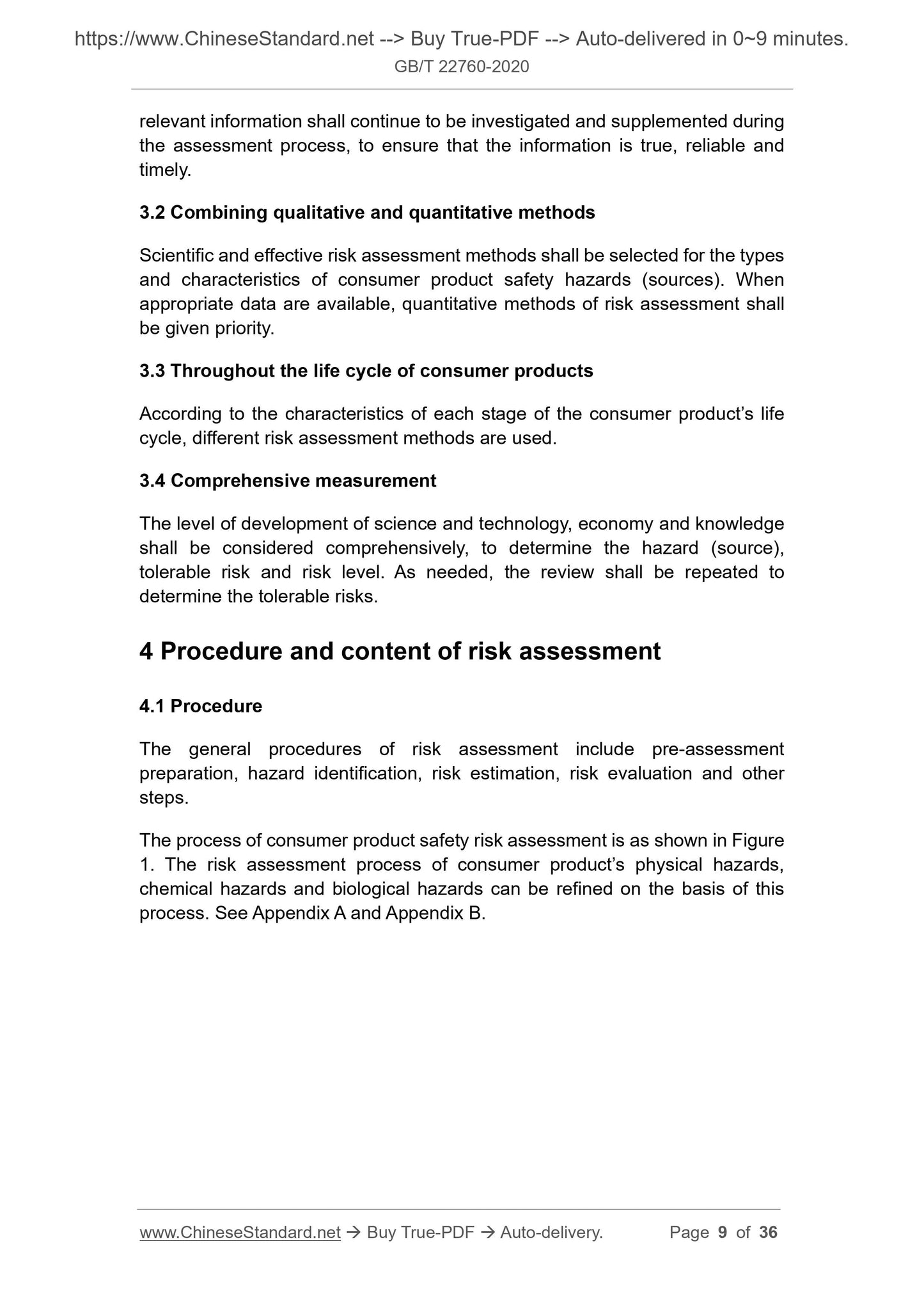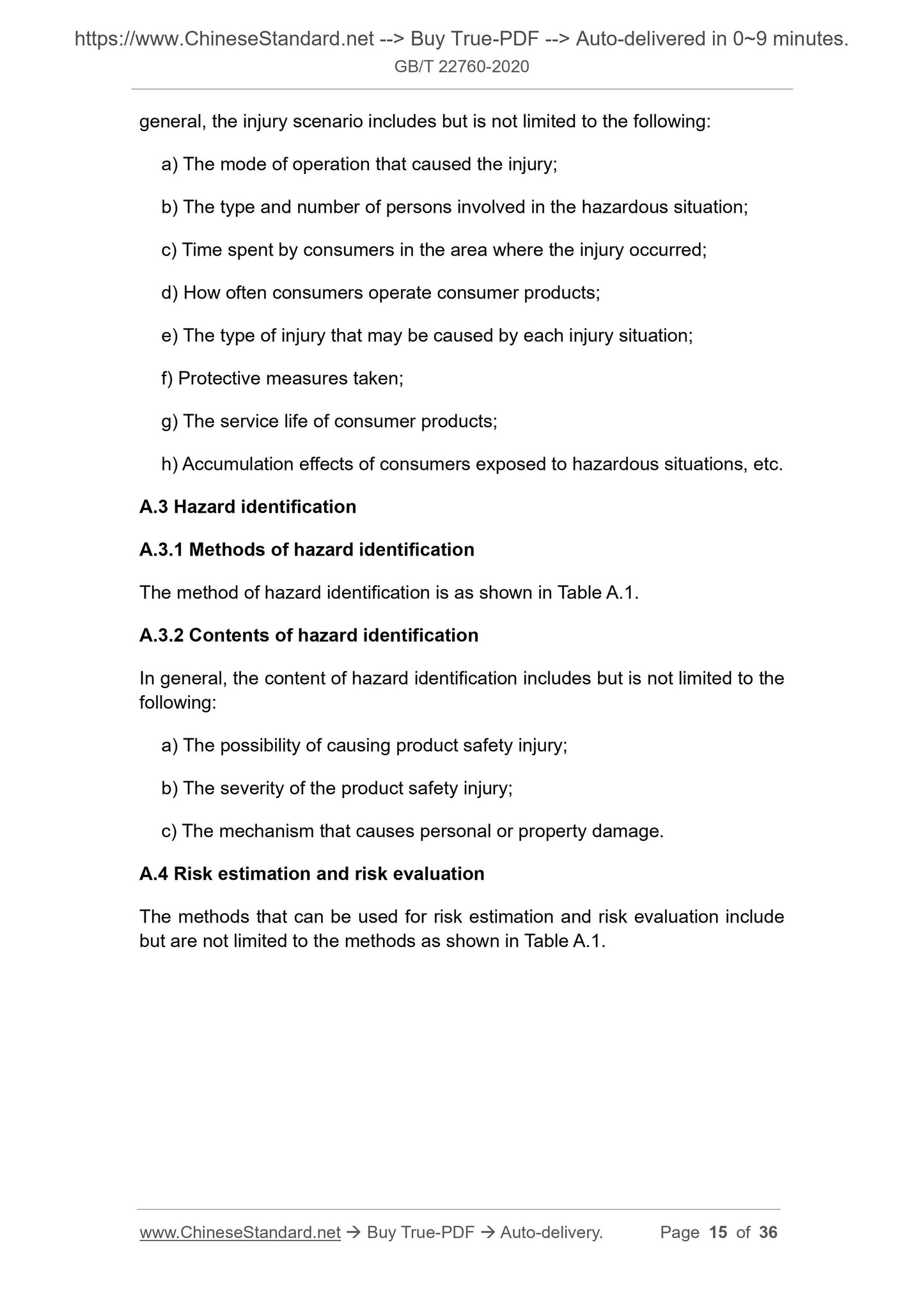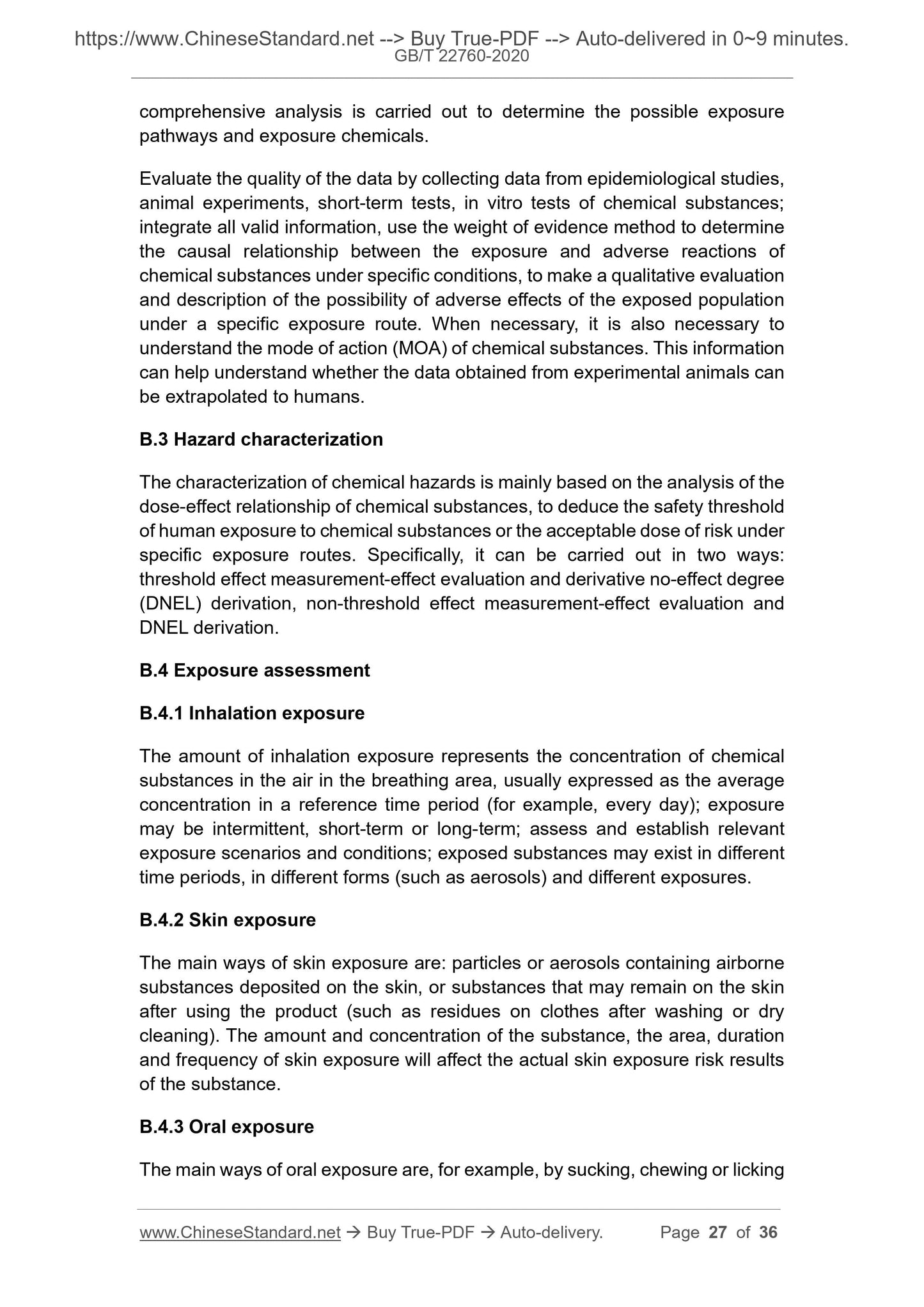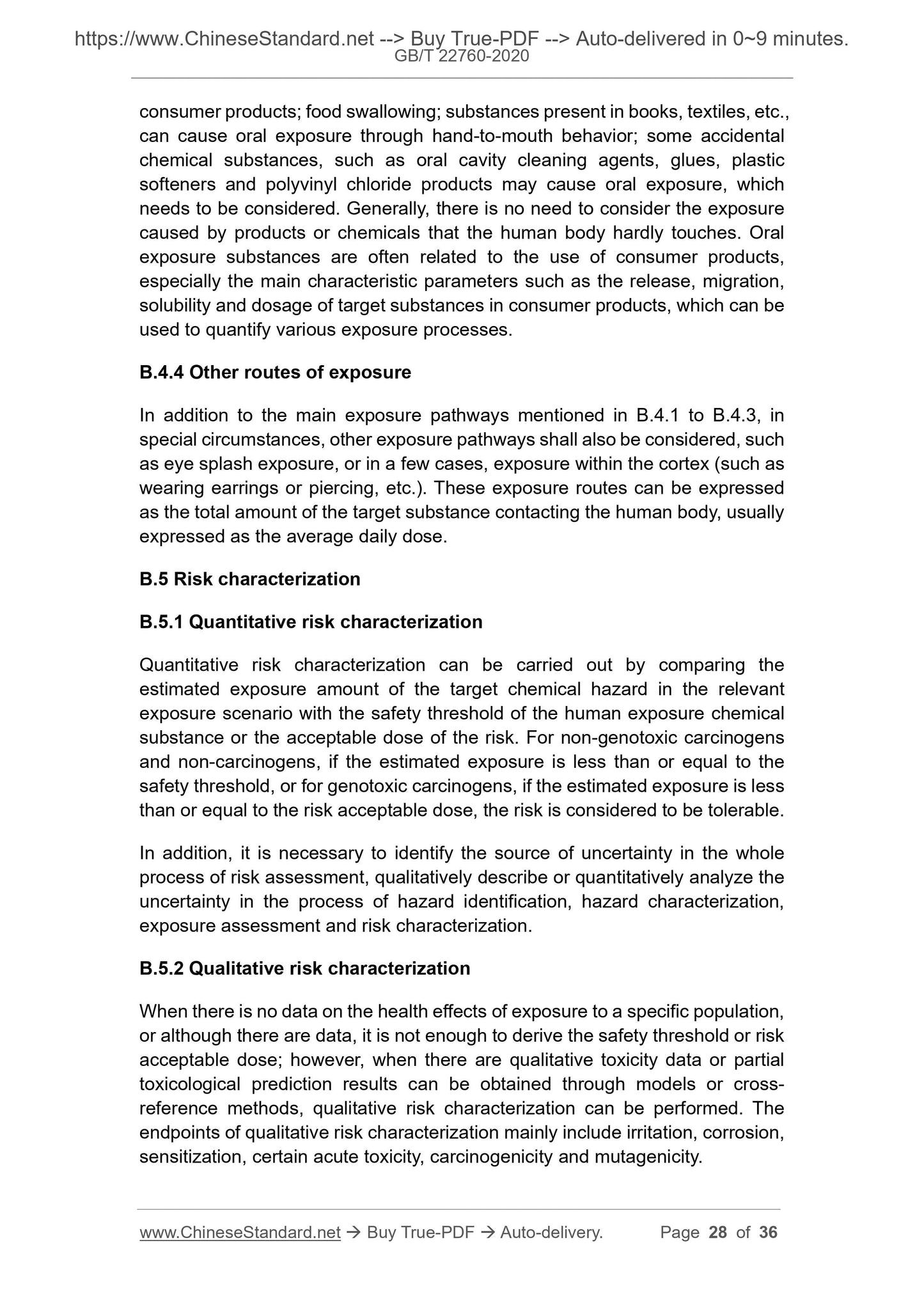1
/
of
8
PayPal, credit cards. Download editable-PDF and invoice in 1 second!
GB/T 22760-2020 English PDF (GBT22760-2020)
GB/T 22760-2020 English PDF (GBT22760-2020)
Regular price
$345.00 USD
Regular price
Sale price
$345.00 USD
Unit price
/
per
Shipping calculated at checkout.
Couldn't load pickup availability
Delivery: 3 seconds. Download true-PDF + Invoice.
Get QUOTATION in 1-minute: Click GB/T 22760-2020
Historical versions: GB/T 22760-2020
Preview True-PDF (Reload/Scroll if blank)
GB/T 22760-2020: Consumer product safety--General principles for risk assessment
GB/T 22760-2020
GB
NATIONAL STANDARD OF THE
PEOPLE’S REPUBLIC OF CHINA
ICS 03.120.01
A 00
Replacing GB/T 22760-2008
Consumer product safety - General principles for risk
assessment
ISSUED ON: JULY 21, 2020
IMPLEMENTED ON: JULY 21, 2020
Issued by: State Administration for Market Regulation;
Standardization Administration of PRC.
Table of Contents
Foreword ... 3
1 Scope ... 5
2 Terms and definitions ... 5
3 General requirements for risk assessment ... 8
4 Procedure and content of risk assessment ... 9
Appendix A (Informative) Risk assessment process and method for physical
hazard of consumer product safety ... 14
Appendix B (Informative) Risk assessment process and method for chemical
hazard and biological hazard of consumer product safety ... 26
Appendix C (Informative) Examples of types of consumer product safety hazard
... 29
Appendix D (Informative) Examples of injury types of consumer product safety
... 33
Appendix E (Informative) Examples of risk classification methods for consumer
product safety hazards ... 35
References ... 36
Consumer product safety - General principles for risk
assessment
1 Scope
This standard specifies the procedures, content and requirements of risk
assessment for consumer product safety.
This standard applies to the risk assessment of consumer products during
normal use and reasonably foreseeable misuse.
2 Terms and definitions
The following terms and definitions apply to this document.
2.1
Consumer product
Mainly but not limited to products designed and produced for personal use,
including product components, parts, accessories, instructions for use and
packaging.
[GB/T 35248-2017, definition 2.2]
2.2
Injury
Damage to human health or property.
Note: Rewrite GB/T 20002.4-2015, definition 3.1.
2.3
Hazard
The potential source which may cause injury.
[GB/T 28803-2012, definition 3.2]
2.4
[GB/T 28803-2012, definition 3.5]
2.10
Intended use
Use according to the information provided by the product and/or system.
When there is no such information, use it in a generally understood mode.
[GB/T 20002.4-2015, definition 3.6]
2.11
Reasonably foreseeable misuse
The use of product and/or system in a manner not provided by the suppler
which is caused by the behavior of a person that is easy to foresee.
[GB/T 20002.4-2015, definition 3.7]
2.12
Tolerable risk
According to the current social value orientation, the risk which is acceptable
within a certain range.
Note: In this standard, "tolerable risk" and "allowable risk" are regarded as
synonyms.
[GB/T 20002.4-2015, definition 3.15]
2.13
Risk estimation
The process of assigning values to the possibility of injury and the severity
of its consequences.
[GB/T 28803-2012, definition 3.13]
2.14
Risk analysis
The process of systematically using existing information to determine
hazards and estimate risks.
[GB/T 20002.4-2015, definition 3.10]
relevant information shall continue to be investigated and supplemented during
the assessment process, to ensure that the information is true, reliable and
timely.
3.2 Combining qualitative and quantitative methods
Scientific and effective risk assessment methods shall be selected for the types
and characteristics of consumer product safety hazards (sources). When
appropriate data are available, quantitative methods of risk assessment shall
be given priority.
3.3 Throughout the life cycle of consumer products
According to the characteristics of each stage of the consumer product’s life
cycle, different risk assessment methods are used.
3.4 Comprehensive measurement
The level of development of science and technology, economy and knowledge
shall be considered comprehensively, to determine the hazard (source),
tolerable risk and risk level. As needed, the review shall be repeated to
determine the tolerable risks.
4 Procedure and content of risk assessment
4.1 Procedure
The general procedures of risk assessment include pre-assessment
preparation, hazard identification, risk estimation, risk evaluation and other
steps.
The process of consumer product safety risk assessment is as shown in Figure
1. The risk assessment process of consumer product’s physical hazards,
chemical hazards and biological hazards can be refined on the basis of this
process. See Appendix A and Appendix B.
general, the injury scenario includes but is not limited to the following:
a) The mode of operation that caused the injury;
b) The type and number of persons involved in the hazardous situation;
c) Time spent by consumers in the area where the injury occurred;
d) How often consumers operate consumer products;
e) The type of injury that may be caused by each injury situation;
f) Protective measures taken;
g) The service life of consumer products;
h) Accumulation effects of consumers exposed to hazardous situations, etc.
A.3 Hazard identification
A.3.1 Methods of hazard identification
The method of hazard identification is as shown in Table A.1.
A.3.2 Contents of hazard identification
In general, the content of hazard identification includes but is not limited to the
following:
a) The possibility of causing product safety injury;
b) The severity of the product safety injury;
c) The mechanism that causes personal or property damage.
A.4 Risk estimation and risk evaluation
The methods that can be used for risk estimation and risk evaluation include
but are not limited to the methods as shown in Table A.1.
comprehensive analysis is carried out to determine the possible exposure
pathways and exposure chemicals.
Evaluate the quality of the data by collecting data from epidemiological studies,
animal experiments, short-term tests, in vitro tests of chemical substances;
integrate all valid information, use the weight of evidence method to determine
the causal relationship between the exposure and adverse reactions of
chemical substances under specific conditions, to make a qualitative evaluation
and description of the possibility of adverse effects of the exposed population
under a specific exposure route. When necessary, it is also necessary to
understand the mode of action (MOA) of chemical substances. This information
can help understand whether the data obtained from experimental animals can
be extrapolated to humans.
B.3 Hazard characterization
The characterization of chemical hazards is mainly based on the analysis of the
dose-effect relationship of chemical substances, to deduce the safety threshold
of human exposure to chemical substances or the acceptable dose of risk under
specific exposure routes. Specifically, it can be carried out in two ways:
threshold effect measurement-effect evaluation and derivative no-effect degree
(DNEL) derivation, non-threshold effect measurement-effect evaluation and
DNEL derivation.
B.4 Exposure assessment
B.4.1 Inhalation exposure
The amount of inhalation exposure represents the concentration of chemical
substances in the air in the breathing area, usually expressed as the average
concentration in a reference time period (for example, every day); exposure
may be intermittent, short-term or long-term; assess and establish relevant
exposure scenarios and conditions; exposed substances may exist in different
time periods, in different forms (such as aerosols) and different exposures.
Get QUOTATION in 1-minute: Click GB/T 22760-2020
Historical versions: GB/T 22760-2020
Preview True-PDF (Reload/Scroll if blank)
GB/T 22760-2020: Consumer product safety--General principles for risk assessment
GB/T 22760-2020
GB
NATIONAL STANDARD OF THE
PEOPLE’S REPUBLIC OF CHINA
ICS 03.120.01
A 00
Replacing GB/T 22760-2008
Consumer product safety - General principles for risk
assessment
ISSUED ON: JULY 21, 2020
IMPLEMENTED ON: JULY 21, 2020
Issued by: State Administration for Market Regulation;
Standardization Administration of PRC.
Table of Contents
Foreword ... 3
1 Scope ... 5
2 Terms and definitions ... 5
3 General requirements for risk assessment ... 8
4 Procedure and content of risk assessment ... 9
Appendix A (Informative) Risk assessment process and method for physical
hazard of consumer product safety ... 14
Appendix B (Informative) Risk assessment process and method for chemical
hazard and biological hazard of consumer product safety ... 26
Appendix C (Informative) Examples of types of consumer product safety hazard
... 29
Appendix D (Informative) Examples of injury types of consumer product safety
... 33
Appendix E (Informative) Examples of risk classification methods for consumer
product safety hazards ... 35
References ... 36
Consumer product safety - General principles for risk
assessment
1 Scope
This standard specifies the procedures, content and requirements of risk
assessment for consumer product safety.
This standard applies to the risk assessment of consumer products during
normal use and reasonably foreseeable misuse.
2 Terms and definitions
The following terms and definitions apply to this document.
2.1
Consumer product
Mainly but not limited to products designed and produced for personal use,
including product components, parts, accessories, instructions for use and
packaging.
[GB/T 35248-2017, definition 2.2]
2.2
Injury
Damage to human health or property.
Note: Rewrite GB/T 20002.4-2015, definition 3.1.
2.3
Hazard
The potential source which may cause injury.
[GB/T 28803-2012, definition 3.2]
2.4
[GB/T 28803-2012, definition 3.5]
2.10
Intended use
Use according to the information provided by the product and/or system.
When there is no such information, use it in a generally understood mode.
[GB/T 20002.4-2015, definition 3.6]
2.11
Reasonably foreseeable misuse
The use of product and/or system in a manner not provided by the suppler
which is caused by the behavior of a person that is easy to foresee.
[GB/T 20002.4-2015, definition 3.7]
2.12
Tolerable risk
According to the current social value orientation, the risk which is acceptable
within a certain range.
Note: In this standard, "tolerable risk" and "allowable risk" are regarded as
synonyms.
[GB/T 20002.4-2015, definition 3.15]
2.13
Risk estimation
The process of assigning values to the possibility of injury and the severity
of its consequences.
[GB/T 28803-2012, definition 3.13]
2.14
Risk analysis
The process of systematically using existing information to determine
hazards and estimate risks.
[GB/T 20002.4-2015, definition 3.10]
relevant information shall continue to be investigated and supplemented during
the assessment process, to ensure that the information is true, reliable and
timely.
3.2 Combining qualitative and quantitative methods
Scientific and effective risk assessment methods shall be selected for the types
and characteristics of consumer product safety hazards (sources). When
appropriate data are available, quantitative methods of risk assessment shall
be given priority.
3.3 Throughout the life cycle of consumer products
According to the characteristics of each stage of the consumer product’s life
cycle, different risk assessment methods are used.
3.4 Comprehensive measurement
The level of development of science and technology, economy and knowledge
shall be considered comprehensively, to determine the hazard (source),
tolerable risk and risk level. As needed, the review shall be repeated to
determine the tolerable risks.
4 Procedure and content of risk assessment
4.1 Procedure
The general procedures of risk assessment include pre-assessment
preparation, hazard identification, risk estimation, risk evaluation and other
steps.
The process of consumer product safety risk assessment is as shown in Figure
1. The risk assessment process of consumer product’s physical hazards,
chemical hazards and biological hazards can be refined on the basis of this
process. See Appendix A and Appendix B.
general, the injury scenario includes but is not limited to the following:
a) The mode of operation that caused the injury;
b) The type and number of persons involved in the hazardous situation;
c) Time spent by consumers in the area where the injury occurred;
d) How often consumers operate consumer products;
e) The type of injury that may be caused by each injury situation;
f) Protective measures taken;
g) The service life of consumer products;
h) Accumulation effects of consumers exposed to hazardous situations, etc.
A.3 Hazard identification
A.3.1 Methods of hazard identification
The method of hazard identification is as shown in Table A.1.
A.3.2 Contents of hazard identification
In general, the content of hazard identification includes but is not limited to the
following:
a) The possibility of causing product safety injury;
b) The severity of the product safety injury;
c) The mechanism that causes personal or property damage.
A.4 Risk estimation and risk evaluation
The methods that can be used for risk estimation and risk evaluation include
but are not limited to the methods as shown in Table A.1.
comprehensive analysis is carried out to determine the possible exposure
pathways and exposure chemicals.
Evaluate the quality of the data by collecting data from epidemiological studies,
animal experiments, short-term tests, in vitro tests of chemical substances;
integrate all valid information, use the weight of evidence method to determine
the causal relationship between the exposure and adverse reactions of
chemical substances under specific conditions, to make a qualitative evaluation
and description of the possibility of adverse effects of the exposed population
under a specific exposure route. When necessary, it is also necessary to
understand the mode of action (MOA) of chemical substances. This information
can help understand whether the data obtained from experimental animals can
be extrapolated to humans.
B.3 Hazard characterization
The characterization of chemical hazards is mainly based on the analysis of the
dose-effect relationship of chemical substances, to deduce the safety threshold
of human exposure to chemical substances or the acceptable dose of risk under
specific exposure routes. Specifically, it can be carried out in two ways:
threshold effect measurement-effect evaluation and derivative no-effect degree
(DNEL) derivation, non-threshold effect measurement-effect evaluation and
DNEL derivation.
B.4 Exposure assessment
B.4.1 Inhalation exposure
The amount of inhalation exposure represents the concentration of chemical
substances in the air in the breathing area, usually expressed as the average
concentration in a reference time period (for example, every day); exposure
may be intermittent, short-term or long-term; assess and establish relevant
exposure scenarios and conditions; exposed substances may exist in different
time periods, in different forms (such as aerosols) and different exposures.
Share
